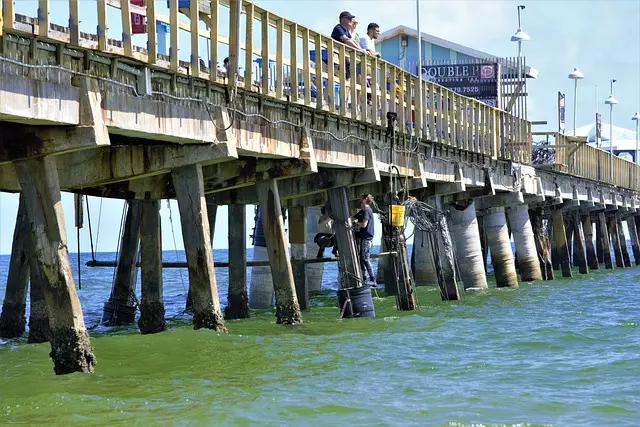Pier and Beam Foundation Repair: Comprehensive Guide to Installation, Maintenance & Restoration
TL;DR:Pier and beam foundations, a traditional support system for seismic and high wind loads, rely…….

TL;DR:
Pier and beam foundations, a traditional support system for seismic and high wind loads, rely on vertical piers transferring weight to horizontal beams. Pier and beam foundation repair requires understanding this structure to assess damage accurately and select restoration methods. Issues like settling, shifting soil, or environmental factors can compromise stability, leading to cracks and misalignments. Damage signs include visible cracks, deformities in piers, corroded beam connections, and bent steel beams.
The repair process begins with a site assessment, excavation around damaged piers, and pouring new concrete for replacement piers. Reinforcement bars are added for strength. Techniques like helical piers, pier replacement, and structural jackets offer effective stabilization. Prompt action is crucial; minor repairs can be DIY, but complex issues require licensed specialists.
Cost considerations vary widely based on damage extent, labor rates, and materials. Regular maintenance, including inspections, drainage management, and weatherproofing, prevents future damage. Case studies demonstrate tailored solutions for historical and modern structures, preserving integrity while meeting safety standards.
“The stability of your home’s foundation is paramount, and pier and beam foundations, common in many regions, require periodic care and repair. This comprehensive guide delves into the intricacies of pier installation, addressing common issues like damage signs, and offering step-by-step processes for both repair and maintenance.
From understanding the basic structure to successful case studies, this article equips homeowners with knowledge on when to seek professional help and cost considerations. Learn how to prevent future damage and ensure your home’s foundation remains a solid pillar.”
Understanding Pier and Beam Foundations: A Basic Overview

Pier and beam foundations, also known as post and beam foundations, are a traditional building technique used to support structures, particularly in areas prone to seismic activity or high wind loads. This type of foundation consists of vertical pier posts that transfer the load from the structure to horizontal beams, which then distribute the weight evenly across the soil. Understanding this system is crucial when it comes to pier and beam foundation repair, as it allows professionals to assess the extent of damage and determine the most effective restoration methods.
The integrity of these foundations relies on proper spacing, material quality, and construction techniques. Over time, factors like settling, shifting soil, or environmental conditions can compromise their stability, leading to cracks, misalignments, or other structural issues that necessitate repair. Identifying signs of damage early on is essential for preserving the longevity of pier and beam structures, ensuring they remain safe and secure for years to come.
Common Issues and Signs of Pier Damage

Pier and beam foundations, a common structural support system, can face various issues over time. One of the primary concerns is pier damage, which may go unnoticed until it reaches critical stages. Common signs include visible cracks or deformities in the piers themselves, often appearing as vertical or diagonal fractures. These defects can result from settling or shifting soil, especially in areas prone to geological instability.
Additionally, beam connections to piers might become loose or corroded due to prolonged exposure to moisture, leading to weak joints and potential structural compromise. Rusted or bent steel beams, along with loose or missing bolts, are clear indicators of damage that requires immediate attention from professionals specializing in pier and beam foundation repair.
The Process of Pier Installation: Step-by-Step Guide

The process of pier installation involves several precise steps to ensure a stable and secure foundation repair. It begins with an extensive site assessment, where experts evaluate the existing structure, identifying any damage or settling issues in the pier and beam foundation. This initial phase is crucial for determining the best course of action and selecting the appropriate materials.
Once the assessment is complete, the team prepares the area, clearing it of any obstructions and ensuring access to the damaged pier. The next step involves excavating around the pier to create a stable base. New concrete is then poured and left to set, forming a solid foundation for the replacement pier. After the concrete has cured, specialized equipment is used to raise and position the new pier into place, aligning it precisely with the existing structure. Reinforcement bars are added for extra strength, and the final touches include filling gaps with concrete and ensuring all connections are secure, thus providing long-lasting support for the building’s structural integrity.
Repair Techniques for Stabilizing Pier Foundations

When it comes to repairing pier and beam foundations, there are several effective techniques that can stabilize and strengthen these structural elements. One common approach is the use of helical piers, which involve installing steel helices into the soil to provide additional support. This method is particularly useful for underpinning weak or settling piers, ensuring the foundation’s integrity. Helical piers can be adjusted to different soil conditions, making them a versatile solution.
Another repair technique includes pier replacement, where damaged or deteriorating piers are removed and replaced with new ones. This may involve adding concrete to enhance the load-bearing capacity of the foundation. Pier stabilization can also be achieved through the application of structural jackets or braces, which provide extra support and prevent further movement or settling. These techniques, when carried out by experienced professionals, offer long-lasting solutions for pier and beam foundation repair.
When to Seek Professional Help for Pier Repair

If your pier and beam foundation is showing signs of damage or instability, it’s crucial to address the issue promptly. While some minor repairs may be tackled yourself, more complex or widespread issues often require the expertise of professional Pier and Beam Foundation Repair specialists. Look out for telltale signs such as uneven floors, cracks in walls or foundations, doors that stick, or windows that are misaligned. These could indicate structural problems that need a thorough assessment by a licensed contractor.
Seeking professional help is especially important for older homes or structures with historical significance, where the repair techniques and materials may differ from modern standards. Reputable contractors will employ safe, effective methods to ensure the longevity and stability of your pier and beam foundation, preventing further damage and costly repairs down the line.
Cost Considerations for Pier and Beam Foundation Repairs

When considering Pier and Beam Foundation Repair, cost is a significant factor for homeowners. The price can vary widely depending on several variables, such as the extent of damage, access to the site, local labor rates, and the specific materials used. Initially, assessing the situation through a thorough inspection is crucial. This step helps in determining whether the repair is merely cosmetic or involves structural reinforcement, which significantly impacts the overall cost.
In many cases, Pier and Beam Foundation Repair can be done relatively affordably for smaller issues. Common repairs include replacing rotted wooden piers or beams, adjusting leaning structures, and realigning misaligned foundation elements. However, more complex problems like extensive wood decay, severe leaning, or structural damage from soil settlement may require significant investment. Homeowners should obtain quotes from multiple contractors to ensure competitive pricing and understand the full range of costs associated with restoring their pier and beam foundation.
Maintenance Tips to Prevent Future Pier Damage

Regular maintenance is key to preserving your pier and beam foundation’s integrity and preventing future damage. Here are some essential tips to keep in mind:
1. Inspect regularly: Conduct routine checks, especially after severe weather events or if you notice any signs of deterioration. Look for cracks in the concrete, signs of rot or insect infestation in wooden components, and ensure all bolts and connectors are tight. Addressing issues early can prevent small problems from escalating into costly repairs.
2. Keep it dry: Moisture is an enemy to any foundation system. Ensure proper drainage around your pier by clearing debris from the base and checking that downspouts direct water away from the structure. Repair or replace any damaged or missing weatherproofing membranes, and consider applying a waterproof coating to protect against seeping water.
Case Studies: Successful Pier Repair Projects

In the realm of pier and beam foundation repair, case studies offer tangible evidence of successful interventions. One notable example involves a historic home in a bustling metropolis that had settled unevenly due to soil erosion. The challenge lay in preserving the structural integrity while minimizing disruption to the surrounding landscape. Through meticulous assessment, engineers devised a plan involving strategic pier replacement and stabilization techniques. This project not only addressed the immediate structural issues but also enhanced the property’s long-term resilience against future settling.
Another successful case involves a modern residential development facing similar foundation problems. The solution here focused on a comprehensive approach that integrated advanced underpinning methods with sophisticated monitoring systems. By reinforcing the existing pier and beam foundation, the project ensured the building’s structural stability for years to come. This case study exemplifies how modern pier repair techniques can revitalize aging structures, ensuring they meet contemporary safety standards while preserving architectural heritage.







